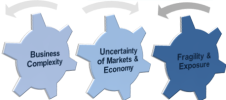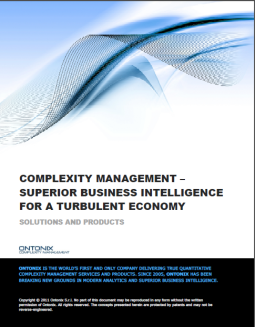Ontonix:: how to correct ratings (or how to stop the manipulation)
Sunday, 30 December, 2012 Leave a comment
When war is just too “dangerous” for the financial masters of the universe (even when their political puppets crave it) i.e. when the bankers aren’t able to effectively bankroll both sides, or the outcome is likely to be detrimental to their ability to retain power in a post-critical landscape – NOTHING to do with the number of innocent victims – their most effective means of waging war is to manipulate global finance!
We have already seen the US pursue a high risk QE strategy, aimed at retaining the, once mighty, USD as the currency of international trade, despite the fact that the American economy is shot (sic). In the unlikely event that one of the Middle East powers had attempted such bully-boy tactics they’d have been, swiftly, sorted out. So perhaps us Europeans should be thankful that we aren’t perceived as such a threat!!?
Nobody pays for a sovereign rating. It comes for free, at an agencies discretion. So, while the agencies decide to favour some countries, they try to discredit others. Ratings have become instruments of politics and strategy, and also weapons in an economic war. The lower the rating, the more it costs a government to sell bonds as it must pay higher interests rates. A downward rating spiral may kill even the healthiest of economies…
What rating agencies do not take into account is the resilience (the opposite of fragility) of an economy. A company/country can perform well form a purely financial perspective but still be fragile. This new aspect of business can easily be taken into account. The same balance sheet, income and cash flow statements can be used to compute the resilience of a company to measure the resilience of its business structure. Once you have the conventional PoD rating and the Resilience Rating™, which ranges from 0% to 100% (100% means the business is very resilient and stable, 0% it is dominated by chaos) you simply multiply the two to obtain a Corrected Rating:
Corrected Rating = PoD Rating X Resilience Rating
This is clear in the image below, which puts together the two
Ontonix – Complex Systems Management, Business Risk Management.
Related articles
- How Crises Model the Modern World (fitforrandomness.wordpress.com)
- Why do some problems defy, no, NOT change? – Part I (fitforrandomness.wordpress.com)
- Institutional Investment:: education comm. “strive to min. complexity” (fitforrandomness.wordpress.com)
- Drivers of Business Complexity & Simplicity (fitforrandomness.wordpress.com)
- China not named currency manipulator (upi.com)
- Who gives a damn what the ratings agencies say? by @DavidOAtkins (digbysblog.blogspot.com)
- Ratings Agencies Ongoing Obsolescence (ritholtz.com)















